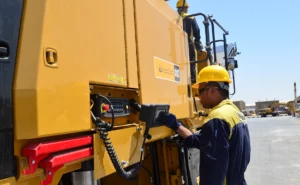Cold planers are a type of asphalt milling machines that can take up demanding tasks and perform well on pavement and concrete surfaces. They are mainly used for the removal of existing asphalt in order to add a new layer, where the reasons could be anything from cracking, potholes, sloping, or other signs of decay.
Cold Planers – How Do They Work?
Although Cold Planers come in a variety of makes and models, their fundamental mechanism remains the same. On an asphalt surface, a cold planer works by applying a rotating drum and cutters for removing the pavement from sub-surface. You can use it either for part of the pavement or entirely, depending on the requirements of your project. The equipment is designed to enable precise control so that operators can easily remove the exact amount of asphalt they want to. All they need to do is apply the cutters at the desired depth and slope to get the right amount of force for the asphalt surface they are working on.
Some Useful Tips on Working with Cold Planers
- Learn How the Controls Work
Before operating any cold planer model, make sure you understand its controls in order to achieve its optimal performance. It may have different switches and displays such as the ignition, continuous flow function, etc. It’s important to take the time out and learn how these controls work, so as to ensure the efficient and safe operation of your machine.
- Be Aware of the Terrain Variations
If your Cold Planer has the creep control feature in it, you will be able to set a constant ground speed, improving the overall quality of milling. However, it is important to be fully aware of any changes in the terrain and adjust the settings accordingly. You must watch out for any such terrain irregularity in the form of bumps, potholes, etc. which could have a major impact your equipment’s operation. If necessary, you can then choose to temporarily disengage the creep control.
- Keep the Cutting Teeth of the Planer in Good Condition
Cold planers come in many varieties to handle different applications. Depending on the amount of asphalt needed to be removed from the road surface, you can choose from cold planers with different spacing, number, and type of cutting drum teeth. The key to ensuring optimized cold planer operation is keeping its teeth in good condition, allowing it to effectively separate the road surface.
- Always Shutdown the Machine Properly
When it comes to shutting down your cold planer, make sure to disengage its continuous flow function. Allowing it to stay idle for some time helps cool down the engine and ensures a safe range of temperature to shut it down.
If you are on a lookout for a quality cold planer with simplified controls which can guarantee unmatched milling precision, you are at the right place!
Our extensive range of Cat Cold Planers available across UAE, Kuwait, Oman, Bahrain, and Qatar, feature top models, including PM 310, PM 312, PM620, PM 820, and many more.
Contact us today and explore the right choices for your business!







